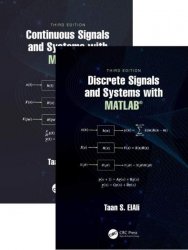Systems and Signal Processing with MATLAB: Two Volume Set, 3rd Edition
- Добавил: literator
- Дата: 25-07-2023, 19:51
- Комментариев: 0
 Название: Systems and Signal Processing with MATLAB: Two Volume Set, 3rd Edition
Название: Systems and Signal Processing with MATLAB: Two Volume Set, 3rd EditionАвтор: Taan S. ElAli
Издательство: Taan S. ElAli
Год: 2021
Страниц: 724
Язык: английский
Формат: pdf (true)
Размер: 55.6 MB
Most books on linear systems for undergraduates cover discrete and continuous systems material together in a single volume. Such books also include topics in discrete and continuous filter design, and discrete and continuous state-space representations. However, with this magnitude of coverage, the student typically gets a little of both discrete and continuous linear systems but not enough of either. Minimal coverage of discrete linear systems material is acceptable provided that there is ample coverage of continuous linear systems. On the other hand, minimal coverage of continuous linear systems does no justice to either of the two areas. Under the best of circumstances, a student needs a solid background in both these subjects.
Continuous linear systems and discrete linear systems are broad topics and each merit a single book devoted to the respective subject matter. The objective of this set of two volumes is to present the needed material for each at the undergraduate level, and present the required material using MATLAB (The MathWorks Inc.).
This book is ideal for use in a one-semester course in continuous linear systems where the instructor can easily cover all of the chapters. Each chapter presents numerous examples that illustrate each concept. Most of the worked-out examples are frst solved analytically and then solved using MATLAB in a clear and understandable fashion.
This book concentrates on explaining the subject matter with easy-to-follow mathematical development and numerous solved examples. The book covers traditional topics and includes an extensive coverage of state-space representation and analysis. The reader does not need to be fuent in MATLAB because the examples are presented in a self-explanatory way.
This book presents three forms of numerical solutions using MATLAB. The frst form allows you to type any command at the MATLAB prompt and then press the Enter key to get the results. The second form is the MATLAB script, a set of MATLAB commands you type and save in a file. You can run this file by typing the file name at the MATLAB prompt and then pressing the Enter key. The third form is the MATLAB function form, where you create the function and run it in the same way you create and run the script file.
We experience signals of various types almost on a continual basis in our daily lives. The blowing of the wind is an example of a continuous wave. We can plot the strength of the wind wave, the velocity of the wave, and the distance it travels as functions of time. When we speak, continuous signals are generated. These spoken word signals travel from one place to another so that other people can hear them. These are our familiar sound waves.
When a radar system detects a certain object in the sky, an electromagnetic signal is sent. This signal leaves the radar system and travels the distance in the air until it hits the target object, which then refects back to the sending radar to be analyzed, where it is decided if the target is present or not. We understand that this electromagnetic signal, whether it is the one being sent or the one being received by the radar, is attenuated (its strength reduced) as it travels away from the radar station. Thus, the attenuation of this electromagnetic signal can be plotted as a function of time. If you vertically attach a certain mass to a spring from one end while the other end is fxed and then pull the mass, oscillations are created such that the spring’s length increases and decreases until the oscillations fnally stop. The oscillations produced are a signal that also dies out with increasing time. This signal, for example, can represent the length of the spring as a function of time.
Volumes in the series:
Volume I – Continuous Signals and Systems with MATLAB
Volume II – Discrete Signals and Systems with MATLAB
Скачать Systems and Signal Processing with MATLAB®: Two Volume Set, 3rd Edition
Внимание
Уважаемый посетитель, Вы зашли на сайт как незарегистрированный пользователь.
Мы рекомендуем Вам зарегистрироваться либо войти на сайт под своим именем.
Уважаемый посетитель, Вы зашли на сайт как незарегистрированный пользователь.
Мы рекомендуем Вам зарегистрироваться либо войти на сайт под своим именем.
Информация
Посетители, находящиеся в группе Гости, не могут оставлять комментарии к данной публикации.
Посетители, находящиеся в группе Гости, не могут оставлять комментарии к данной публикации.
